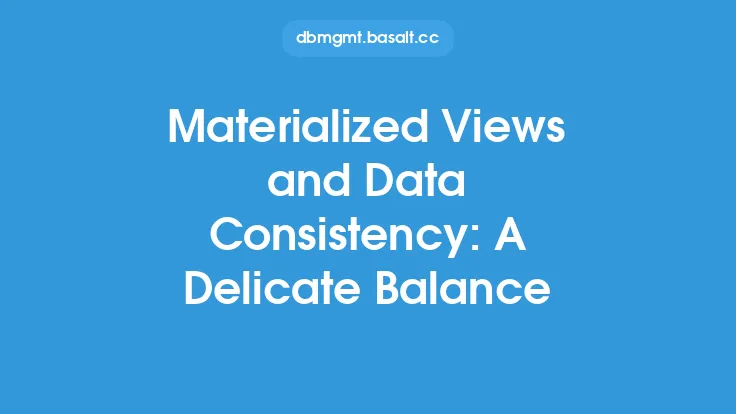Data denormalization is a technique used in database design to improve the performance of queries by reducing the number of joins required to retrieve data. One of the key tools used in data denormalization is the summary table, which is a pre-computed table that contains aggregated data. While summary tables can greatly improve query performance, they also introduce a new level of complexity to the database, particularly when it comes to maintaining data integrity.
Introduction to Summary Tables and Data Integrity
Summary tables are designed to store pre-computed results of complex queries, allowing for faster retrieval of data. However, this pre-computation comes at a cost: the data in the summary table must be kept in sync with the underlying data. This can be a challenging task, particularly in databases with high transaction volumes or complex data relationships. Ensuring data integrity in summary tables requires careful planning and design, as well as ongoing maintenance and monitoring.
The Challenges of Maintaining Data Integrity in Summary Tables
Maintaining data integrity in summary tables is a delicate balance between ensuring that the data is up-to-date and minimizing the impact on database performance. There are several challenges to consider, including:
- Data freshness: The data in the summary table must be kept up-to-date with the underlying data. This can be a challenge, particularly if the underlying data is changing rapidly.
- Data consistency: The data in the summary table must be consistent with the underlying data. This can be a challenge, particularly if there are multiple sources of data or complex data relationships.
- Data accuracy: The data in the summary table must be accurate and free from errors. This can be a challenge, particularly if the data is being aggregated or transformed in some way.
Techniques for Maintaining Data Integrity in Summary Tables
There are several techniques that can be used to maintain data integrity in summary tables, including:
- Materialized views: A materialized view is a pre-computed result set that is stored in a table. Materialized views can be used to implement summary tables and can be updated automatically by the database.
- Triggers: Triggers are database procedures that are executed automatically when certain events occur. Triggers can be used to update summary tables when the underlying data changes.
- Scheduled updates: Summary tables can be updated on a scheduled basis, such as nightly or weekly. This can be a good option if the data is not changing rapidly and the database is not heavily loaded.
- Real-time updates: Summary tables can be updated in real-time, as the underlying data changes. This can be a good option if the data is changing rapidly and the database is heavily loaded.
Best Practices for Ensuring Data Integrity in Summary Tables
There are several best practices that can be followed to ensure data integrity in summary tables, including:
- Monitor data freshness: Regularly monitor the data in the summary table to ensure that it is up-to-date with the underlying data.
- Use data validation: Use data validation techniques, such as checks and constraints, to ensure that the data in the summary table is accurate and consistent.
- Test and verify: Regularly test and verify the data in the summary table to ensure that it is accurate and consistent.
- Document and maintain: Document the summary table and its maintenance procedures, and regularly review and update them to ensure that they are still relevant and effective.
Common Pitfalls to Avoid
There are several common pitfalls to avoid when maintaining data integrity in summary tables, including:
- Over-reliance on manual updates: Relying too heavily on manual updates can lead to errors and inconsistencies in the data.
- Inadequate testing: Failing to adequately test the data in the summary table can lead to errors and inconsistencies.
- Insufficient monitoring: Failing to regularly monitor the data in the summary table can lead to errors and inconsistencies.
- Poor documentation: Failing to document the summary table and its maintenance procedures can lead to confusion and errors.
Conclusion
Maintaining data integrity in summary tables is a delicate balance between ensuring that the data is up-to-date and minimizing the impact on database performance. By using techniques such as materialized views, triggers, and scheduled updates, and following best practices such as monitoring data freshness, using data validation, and testing and verifying the data, database administrators can ensure that their summary tables are accurate, consistent, and reliable. By avoiding common pitfalls such as over-reliance on manual updates, inadequate testing, insufficient monitoring, and poor documentation, database administrators can ensure that their summary tables are a valuable asset to their organization, rather than a liability.





